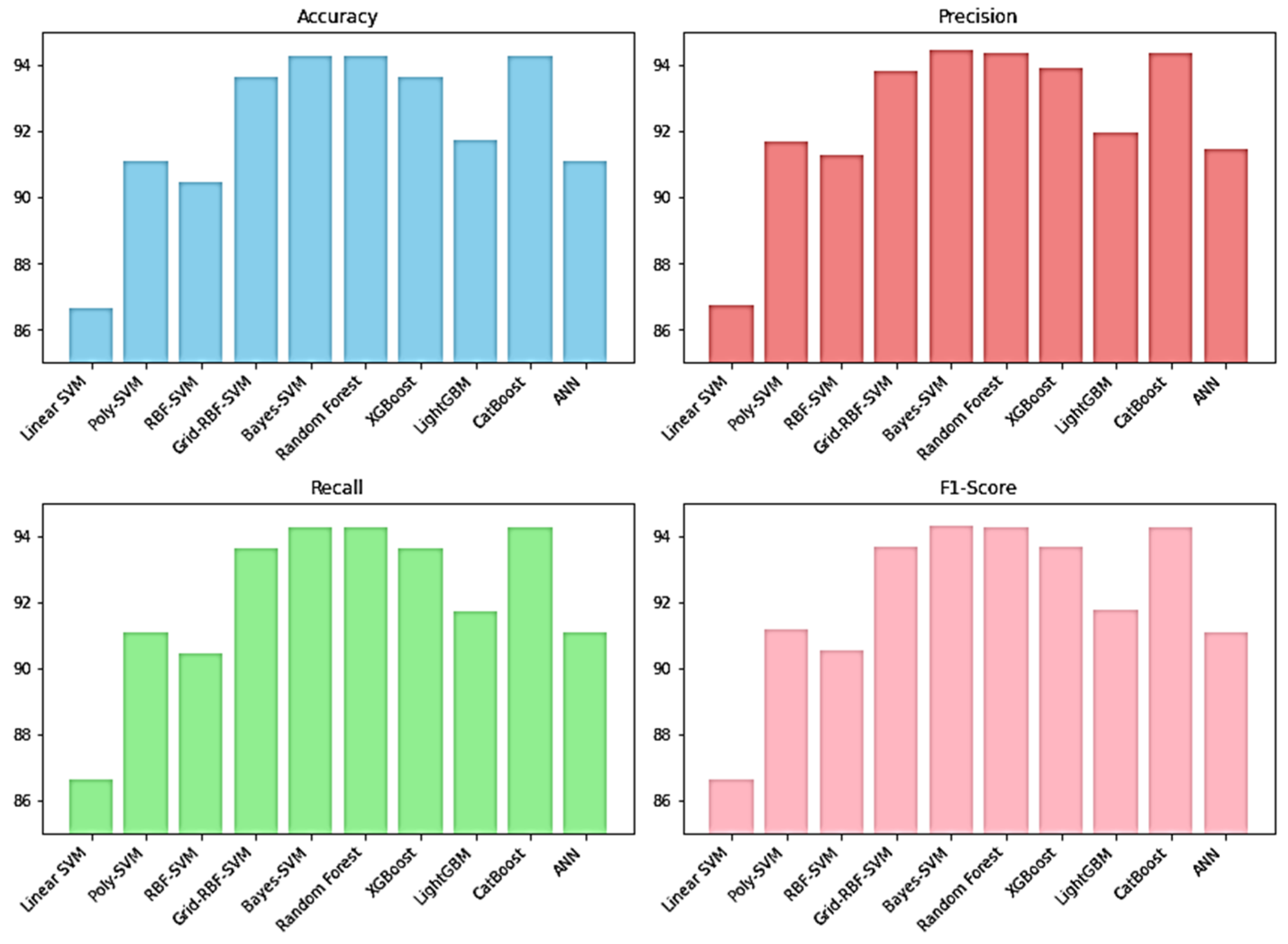Machine Learning-Based Forest Type Mapping from Multi-Temporal Remote Sensing Data: Performance and Comparative Analysis †
Abstract
:1. Introduction
2. Related Work
3. Materials and Methods
3.1. Data Acquisition
3.2. Feature Extraction
- b1 to b9: These are bands of spectral information captured by ASTER imagery encompassing the green, red, and near-infrared wavelengths, acquired on three different dates (26 September 2010; 19 March 2011; and 8 May 2011).
- pred_minus_obs_S_b1 to pred_minus_obs_S_b9: These values represent the difference between the spectral values predicted through spatial interpolation and the actual spectral values for the ‘s’ class across bands b1 to b9.
- pred_minus_obs_H_b1 to pred_minus_obs_H_b9: Similarly, these values denote the variance between the predicted spectral values obtained via spatial interpolation and the actual spectral values for the ‘h’ class across bands b1 to b9.
3.3. Model Training
3.4. Model Evaluation
3.5. SVM Parameter Optimization
4. Results and Discussion
5. Conclusions
Author Contributions
Funding
Institutional Review Board Statement
Informed Consent Statement
Data Availability Statement
Conflicts of Interest
References
- Shang, X.; Chisholm, L.A. Classification of Australian native forest species using hyperspectral remote sensing and machine-learning classification algorithms. IEEE J. Sel. Top. Appl. Earth Obs. Remote Sens. 2013, 7, 2481–2489. [Google Scholar] [CrossRef]
- Boschetti, M.; Boschetti, L.; Oliveri, S.; Casati, L.; Canova, I. Tree species mapping with Airborne hyper-spectral MIVIS data: The Ticino Park study case. Int. J. Remote Sens. 2007, 28, 1251–1261. [Google Scholar] [CrossRef]
- Joshi, C.; De Leeuw, J.; van Duren, I.C. Remote sensing and GIS applications for mapping and spatial modelling of invasive species. In Proceedings of the ISPRS, Istanbul, Turkey, 12–23 July 2004; p. B7. [Google Scholar]
- Biswas, S.; Huang, Q.; Anand, A.; Mon, M.S.; Arnold, F.-E.; Leimgruber, P. A multi sensor approach to forest type mapping for advancing monitoring of sustainable development goals (SDG) in Myanmar. Remote Sens. 2020, 12, 3220. [Google Scholar] [CrossRef]
- Ahirwal, J.; Gogoi, A.; Sahoo, U.K. Stability of soil organic carbon pools affected by land use and land cover changes in forests of eastern Himalayan region, India. Catena 2022, 215, 106308. [Google Scholar] [CrossRef]
- Rodriguez-Galiano, V.F.; Ghimire, B.; Rogan, J.; Chica-Olmo, M.; Rigol-Sanchez, J.P. An assessment of the effectiveness of a random forest classifier for land-cover classification. ISPRS J. Photogramm. Remote Sens. 2012, 67, 93–104. [Google Scholar] [CrossRef]
- Liu, Y.; Gong, W.; Hu, X.; Gong, J. Forest type identification with random forest using Sentinel-1A, Sentinel-2A, multi-temporal Landsat-8 and DEM data. Remote Sens. 2018, 10, 946. [Google Scholar] [CrossRef]
- Zhang, L.; Wan, X.; Sun, B. Tropical natural forest classification using time-series Sentinel-1 and Landsat-8 images in Hainan Island. In Proceedings of the IGARSS 2019-2019 IEEE International Geoscience and Remote Sensing Symposium, Yokohama, Japan, 28 July–2 August 2019; pp. 6732–6735. [Google Scholar]
- Cheng, K.; Wang, J. Forest-type classification using time-weighted dynamic time warping analysis in mountain areas: A case study in southern China. Forests 2019, 10, 1040. [Google Scholar] [CrossRef]
- Hościło, A.; Lewandowska, A. Mapping forest type and tree species on a regional scale using multi-temporal Sentinel-2 data. Remote Sens. 2019, 11, 929. [Google Scholar] [CrossRef]
- Guo, Y.; Li, Z.; Chen, E.; Zhang, X.; Zhao, L.; Xu, E.; Hou, Y.; Liu, L. A deep fusion unet for mapping forests at tree species levels with multi-temporal high spatial resolution satellite imagery. Remote Sens. 2021, 13, 3613. [Google Scholar] [CrossRef]
- Johnson, B. Forest Type Mapping. 2015. Available online: https://archive.ics.uci.edu/dataset/333/forest+type+mapping (accessed on 10 March 2023).

| Model | Accuracy (%) | Precision (%) | Recall (%) | F1-Score (%) |
|---|---|---|---|---|
| Linear SVM | 86.62 | 86.72 | 86.62 | 86.62 |
| Poly-SVM | 91.08 | 91.66 | 91.08 | 91.17 |
| RBF-SVM | 90.45 | 91.25 | 90.45 | 90.54 |
| Grid-RBF-SVM | 93.63 | 93.81 | 93.63 | 93.68 |
| Bayes-SVM | 94.27 | 94.46 | 94.27 | 94.32 |
| Random Forest | 94.27 | 94.36 | 94.27 | 94.28 |
| XGBoost | 93.63 | 93.88 | 93.63 | 93.67 |
| LightGBM | 91.72 | 91.95 | 91.72 | 91.76 |
| CatBoost | 94.27 | 94.37 | 94.27 | 94.28 |
| ANN | 91.08 | 91.47 | 91.08 | 91.09 |
Disclaimer/Publisher’s Note: The statements, opinions and data contained in all publications are solely those of the individual author(s) and contributor(s) and not of MDPI and/or the editor(s). MDPI and/or the editor(s) disclaim responsibility for any injury to people or property resulting from any ideas, methods, instructions or products referred to in the content. |
© 2023 by the authors. Licensee MDPI, Basel, Switzerland. This article is an open access article distributed under the terms and conditions of the Creative Commons Attribution (CC BY) license (https://creativecommons.org/licenses/by/4.0/).
Share and Cite
Ibrahim, Y.; Bagaye, U.Y.; Muhammad, A.I. Machine Learning-Based Forest Type Mapping from Multi-Temporal Remote Sensing Data: Performance and Comparative Analysis. Environ. Sci. Proc. 2024, 29, 9. https://doi.org/10.3390/ECRS2023-15848
Ibrahim Y, Bagaye UY, Muhammad AI. Machine Learning-Based Forest Type Mapping from Multi-Temporal Remote Sensing Data: Performance and Comparative Analysis. Environmental Sciences Proceedings. 2024; 29(1):9. https://doi.org/10.3390/ECRS2023-15848
Chicago/Turabian StyleIbrahim, Yusuf, Umar Yusuf Bagaye, and Abubakar Ibrahim Muhammad. 2024. "Machine Learning-Based Forest Type Mapping from Multi-Temporal Remote Sensing Data: Performance and Comparative Analysis" Environmental Sciences Proceedings 29, no. 1: 9. https://doi.org/10.3390/ECRS2023-15848
APA StyleIbrahim, Y., Bagaye, U. Y., & Muhammad, A. I. (2024). Machine Learning-Based Forest Type Mapping from Multi-Temporal Remote Sensing Data: Performance and Comparative Analysis. Environmental Sciences Proceedings, 29(1), 9. https://doi.org/10.3390/ECRS2023-15848







